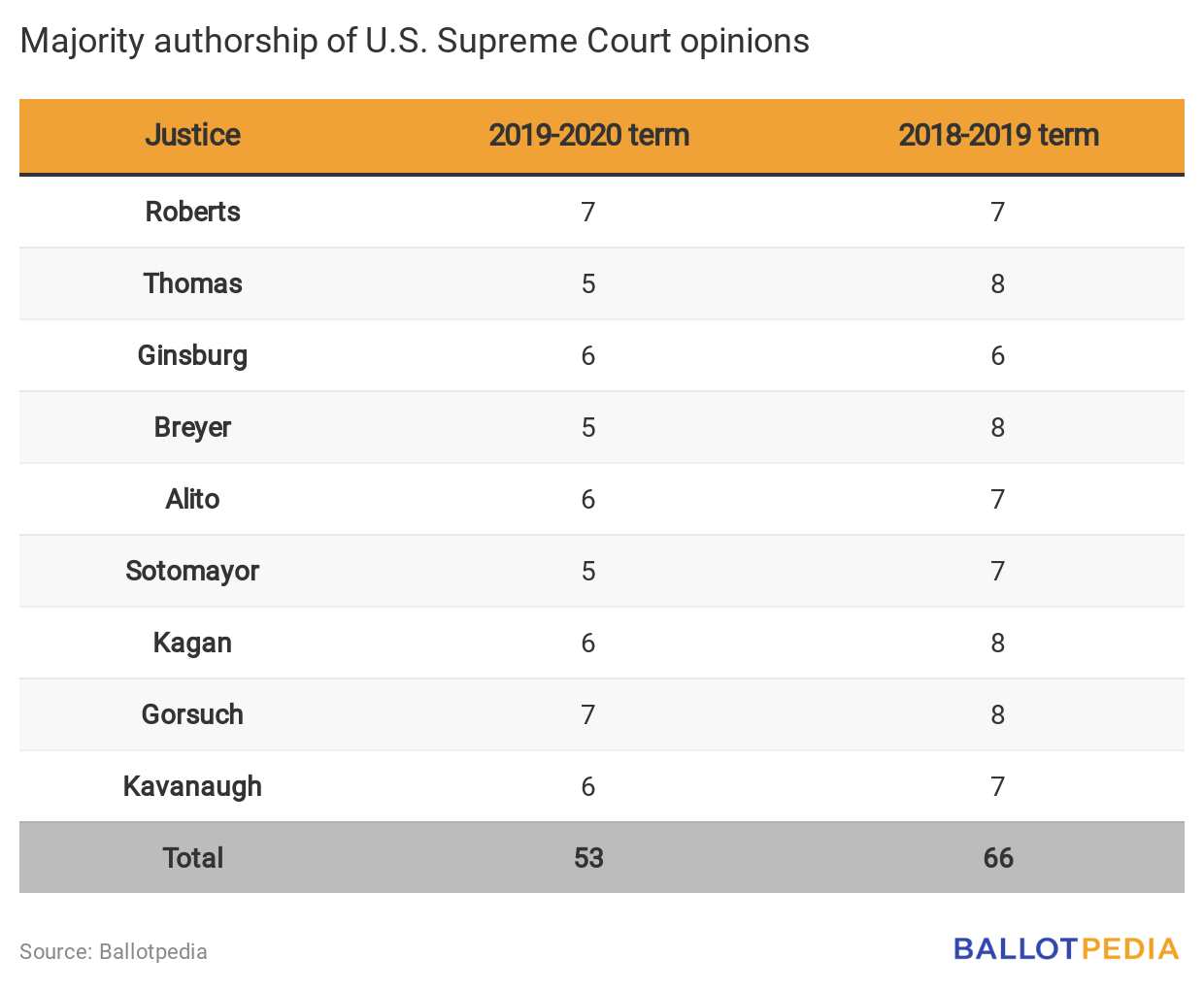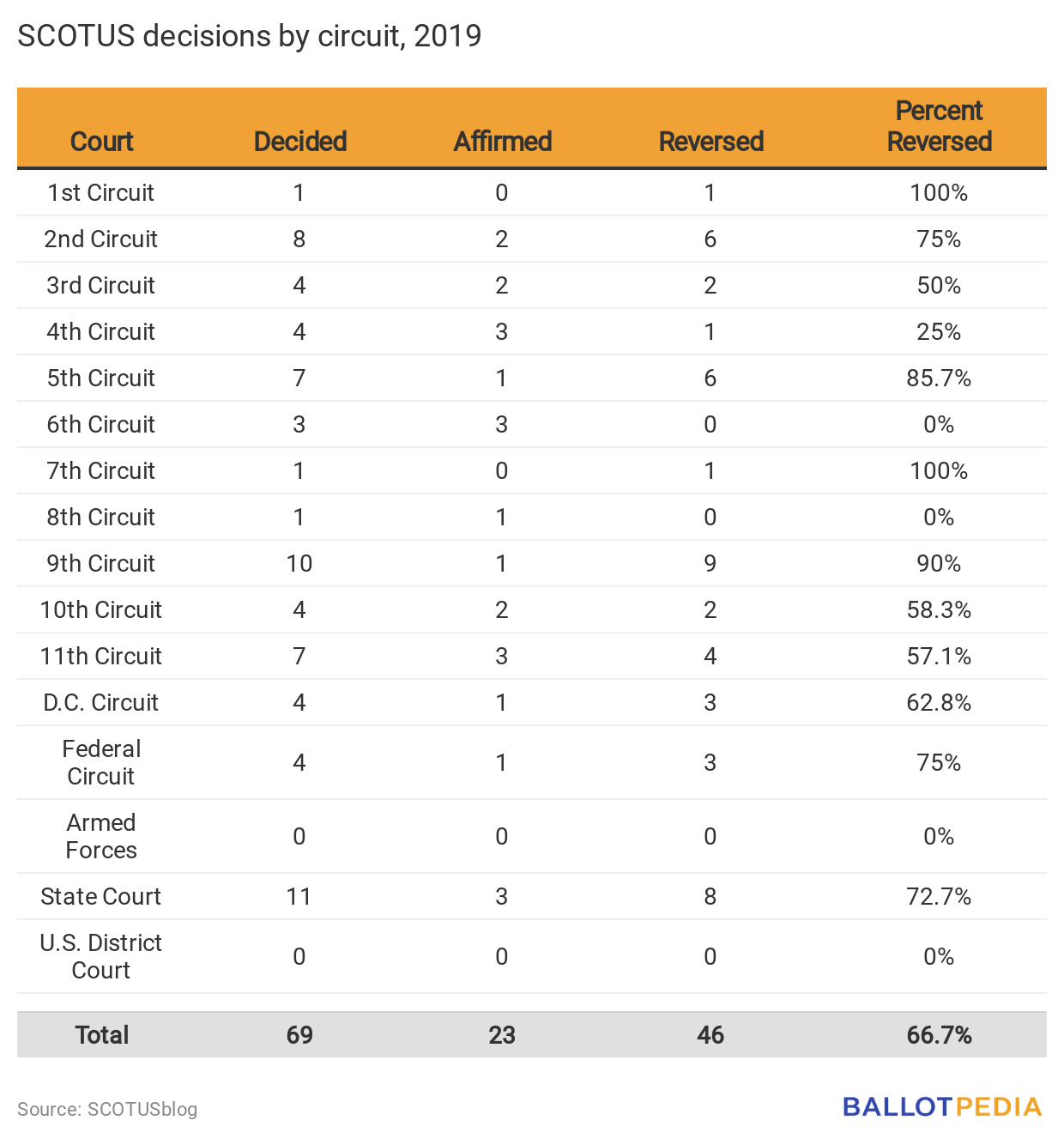| Welcome to the August 3 edition of Bold Justice, Ballotpedia’s newsletter about the Supreme Court of the United States (SCOTUS) and other judicial happenings around the U.S. Don’t want to check out while SCOTUS is on recess? Keep up with the latest news by following us on Twitter or subscribing to the Daily Brew. |
The Supreme Court finished its 2019-2020 term on July 9. The court agreed to hear arguments in 74 cases, but heard arguments in only 61 cases due to the coronavirus pandemic. Click here to read more about SCOTUS’ 2019-2020 term.
Opinion authorshipThe court released 53 signed opinions, meaning the authorship was indicated. Some opinions are per curiam, or unsigned. Chief Justice John Roberts and Justice Neil Gorsuch wrote the most opinions this term. Justices Thomas, Breyer, Alito, Sotomayor, Kagan, Gorsuch, and Kavanaugh all wrote more opinions in the 2018-19 term than in the 2019-2020 term. However, the court heard fewer arguments in 2019-2020 due to the coronavirus pandemic.
The chart below indicates the number and types of opinions each justice wrote during the 2019-2020 term. Justice Roberts and Gorsuch wrote the most opinions with seven each. Justices Thomas, Breyer, and Sotomayor wrote the least, with five opinions each.
5-4 decisionsThe court issued 13 5-4 or 5-3 decisions, which was 21% of the total opinions released. Those decisions were made by four different configurations of justices. In 69% of these decisions, the five justices appointed by Republican presidents (Roberts, Thomas, Alito, Gorsuch, and Kavanaugh) made up the majority. In the rest, a Republican appointee joined the four justices appointed by Democratic presidents (Ginsburg, Breyer, Sotomayor, Kagan) to reach a majority. Since the 2005-2006 term, 21% of the opinions released in a term were 5-4 opinions. The court had the highest percentage of 5-4 opinions in the 2006-2007 term (33%) and the lowest percentage of 5-4 opinions in the 2015-2016 term (5%).
Reversal ratesSince 2007, SCOTUS has released opinions in 993 cases. Of those, it reversed a lower court decision 696 times (70.1%) while affirming a lower court decision 289 times (29%). Eight of the 993 cases were original jurisdiction, meaning the U.S. Supreme Court was the only court to hear that case. These cases cannot affirm or reverse a lower court ruling. Click here for more information on SCOTUS reversal rates from 2007 to the present.
SCOTUS issued opinions in 69 cases* during the 2019-2020 term. It reversed 46 lower court decisions (66.7%) and affirmed 23. This term’s reversal rate was 3.4 percentage points lower than the average rate of reversal since 2007 (70.1%). *Ballotpedia uses data provided by SCOTUSblog. SCOTUSblog counts some consolidated cases as separate opinions because of the way the opinions impact lower court rulings. Since 2007, SCOTUS has decided more cases originating from the 9th Circuit (191) than from any other circuit. The court decided the second-most cases from the 2nd Circuit (73). During that span, SCOTUS overturned a greater number of cases originating from the 9th Circuit (149, or 78%), but it overturned a higher percentage of cases originating in the 6th Circuit (55 of 69 cases, or 79.7%).
Upcoming SCOTUS datesThe justices are on summer recess. Here are the court’s upcoming dates of interest:
|
|
|
 We’ll be back on August 10 with a new edition of Bold Justice. |
Bold Justice: Reversal rates edition
By








